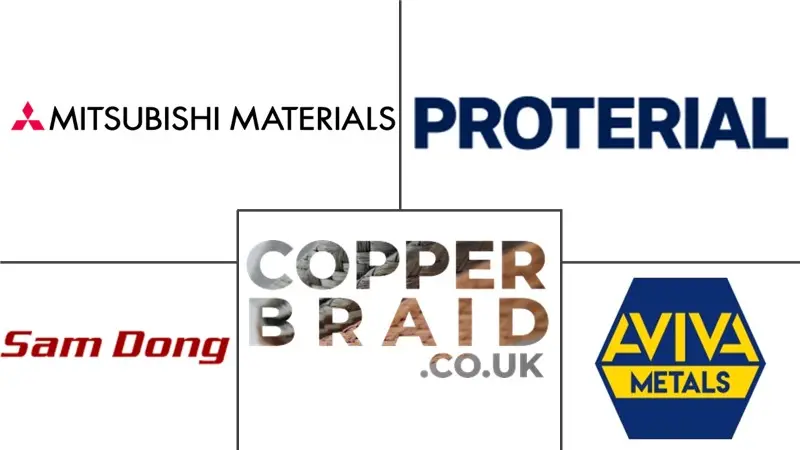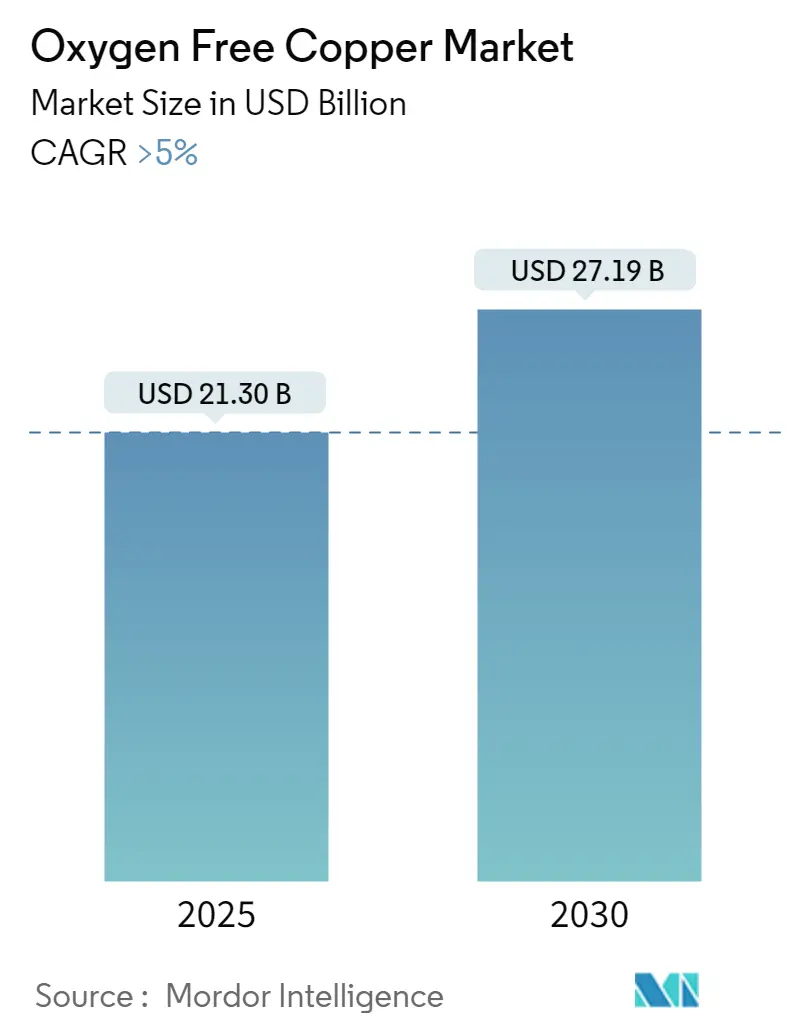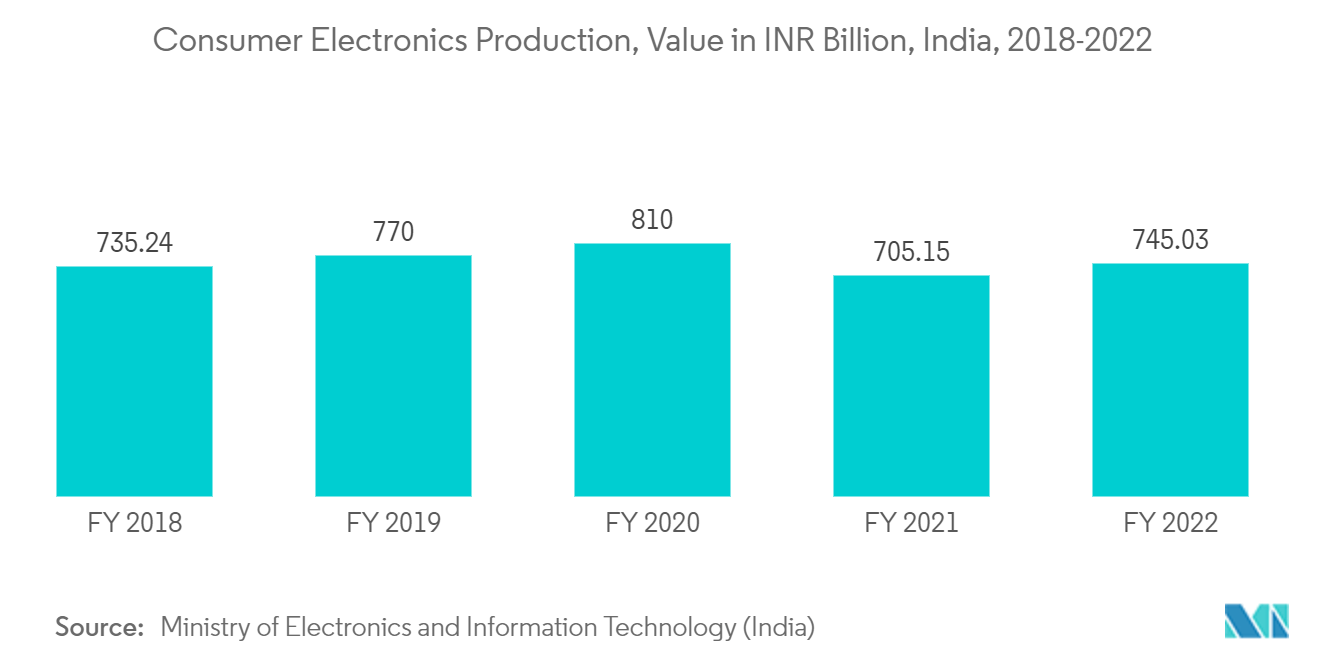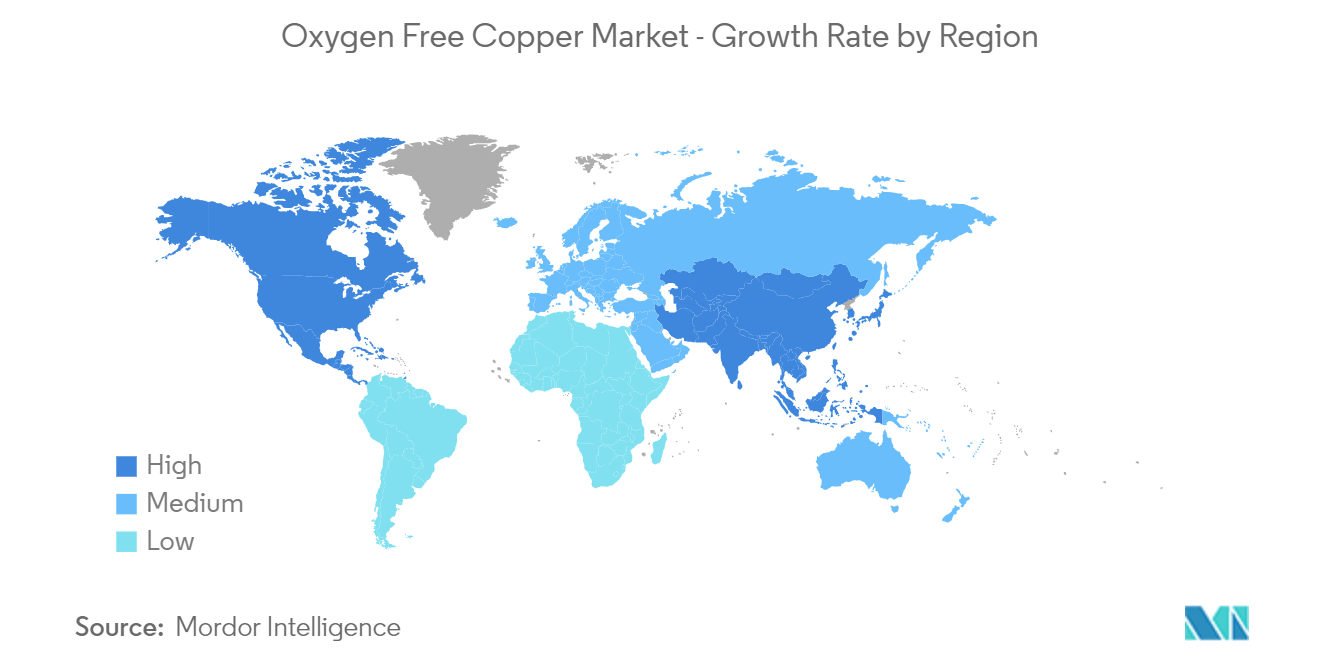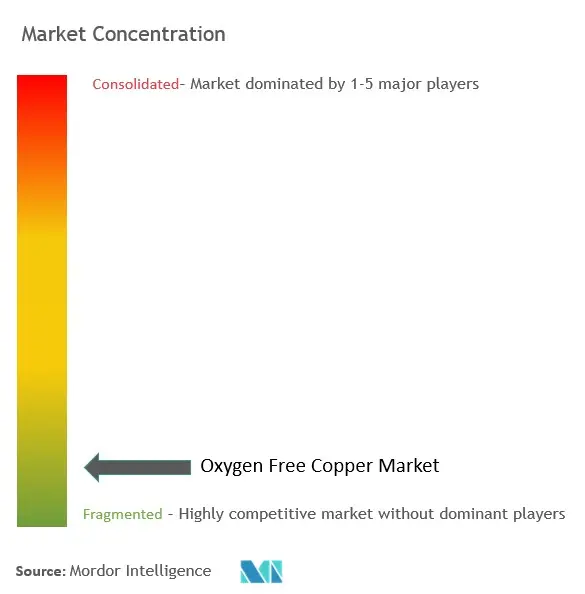Oxygen Free Copper Market Analysis
The Oxygen Free Copper Market size is estimated at USD 21.30 billion in 2025, and is expected to reach USD 27.19 billion by 2030, at a CAGR of greater than 5% during the forecast period (2025-2030).
The oxygen-free copper market is gaining traction due to its superior electrical conductivity and high purity, which are essential for various high-performance applications. This type of copper is particularly valued in industries where the highest levels of electrical conductivity and resistance to corrosion are critical, such as electronics, automotive, and industrial sectors. As these industries continue to advance technologically, the demand for high-purity copper with low oxygen content is increasing. This demand is especially strong in the semiconductor and automotive sectors, where oxygen-free copper plays a crucial role in enhancing the performance and reliability of components.
Advantages of Oxygen-Free Copper in High-Performance Applications
- Superior Electrical Properties: Oxygen-free copper (OFC) is renowned for its excellent electrical properties, which surpass those of standard electrolytic tough pitch (ETP) copper. Its production involves controlled processes to ensure minimal oxygen content, resulting in high conductivity and the elimination of oxide inclusions that can cause defects in the final product. This makes it the preferred material for applications where precision and reliability are paramount, such as high-frequency electronics, high-end audio equipment, and critical automotive components.
- Role in Emerging Technologies: The market for oxygen-free copper is also driven by its applications in emerging technologies. As global demand for electric vehicles (EVs) and renewable energy systems grows, the use of oxygen-free copper in these applications is expected to rise. This is due to the copper's high conductivity and thermal performance, which are essential for improving the efficiency and performance of EVs and other advanced electronic systems.
Rising Need for High-Purity Copper in Semiconductors
- Semiconductor Industry Demand: The semiconductor industry is a significant driver of the oxygen-free copper market. OFC’s high conductivity and purity are critical for the manufacturing of semiconductor devices, which require materials with minimal impurities to ensure optimal performance. The increasing complexity and miniaturization of semiconductor devices have further amplified the demand for high-quality materials like OFC. As manufacturers push the limits of technology, the need for materials that offer superior performance and reliability becomes paramount.
- Impact of Technological Advancements: Additionally, the ongoing expansion of data centers and the advent of 5G technology are fueling the demand for semiconductors, thereby indirectly boosting the need for oxygen-free copper. These applications require materials that can handle high data transfer rates and operate efficiently under demanding conditions, further solidifying the role of oxygen-free copper in the semiconductor industry.
Expanding Use of Oxygen-Free Copper in Automotive Applications
- Growth in Electric Vehicles: The automotive sector is another significant contributor to the growing demand for oxygen-free copper. As the industry shifts towards electrification, the use of OFC in electric vehicles (EVs) and hybrid electric vehicles (HEVs) is increasing. OFC is used in various automotive components, including wiring, connectors, and battery systems, where its high conductivity and resistance to corrosion are crucial for ensuring efficiency and reliability.
- Advanced Automotive Technologies: With the global push towards reducing carbon emissions, automakers are investing heavily in EVs, which require materials that can handle higher electrical loads while maintaining performance. Moreover, the focus on advanced driver-assistance systems (ADAS) and autonomous driving technologies is further driving the demand for oxygen-free copper. These systems rely on complex electronic architectures that require materials with excellent conductivity and thermal management properties, making OFC a key material in developing next-generation automotive technologies.
Oxygen Free Copper Market Trends
Electrical and Electronics Industry to Dominate the Market
- The oxygen-free copper (OFC) market is witnessing substantial growth, mainly driven by its extensive use in the electrical and electronics sectors. OFC is highly preferred due to its superior conductivity and high purity, making it ideal for critical applications where performance is key. The demand for high conductivity copper is particularly robust in areas requiring minimal electrical losses, such as telecommunications, semiconductors, and precision electronics.
- High Purity and Conductivity Advantages: OFC stands out against traditional copper types like electrolytic tough pitch copper due to its higher purity and lower oxygen content, leading to enhanced conductivity. This makes OFC especially suitable for manufacturing components such as connectors, cables, and printed circuit boards (PCBs). The market is further propelled by OFC's resistance to corrosion, which extends its lifespan in electrical applications, particularly in advanced electronic devices.
- Impact of Rising Production Costs: The OFC manufacturing process involves precise techniques that minimize contamination, ensuring copper purity levels of 99.99%. This purity not only improves electrical properties but also justifies the higher production costs associated with OFC. As production costs rise, prices are expected to remain elevated; however, the benefits of reduced energy losses and increased product durability outweigh these costs.
Asia-Pacific Region to Dominate the Market
- The Asia-Pacific region is poised to dominate the oxygen-free copper market, driven by rapid industrialization and a booming electronics industry in countries like China, Japan, and South Korea. The region’s growth is closely tied to the expanding automotive and electronics sectors, with OFC being increasingly used in electric vehicles (EVs) for efficient power transmission. Additionally, the presence of key OFC suppliers and manufacturers scaling up production to meet demand further solidifies the region’s dominance.
Oxygen Free Copper Industry Overview
- Fragmented Market Structure: The oxygen-free copper market is highly fragmented, with many players competing for market share. Unlike consolidated markets where a few companies dominate, this market is characterized by the presence of numerous small to medium-sized companies alongside a few large global corporations. This fragmentation reflects the diverse range of applications and demand across various industries, including electronics, telecommunications, and electrical engineering.
- Leading Companies Drive Innovation: Despite the market's fragmented nature, a few key players have established themselves as leaders through innovation and extensive global operations. Companies like Copper Braid Products, Aviva Metals, Mitsubishi Materials Corporation, PROTERIAL Ltd., and Sam Dong are recognized for their high-quality oxygen-free copper products and advanced manufacturing capabilities. These companies have invested significantly in research and development to meet the evolving needs of industries that require high-purity copper with excellent conductivity and durability.
- Future Success Strategies: To succeed in the oxygen-free copper market, companies must focus on enhancing product quality and customization to meet specific industry requirements. Investing in sustainable production methods and expanding their global footprint are also critical strategies for market players. Additionally, as technological advancements drive demand in sectors like electronics and electric vehicles, companies that can quickly adapt to these trends are likely to gain a competitive edge.
Oxygen Free Copper Market Leaders
-
Copper Braid Products
-
Aviva Metals
-
Mitsubishi Materials Corporation
-
PROTERIAL, Ltd.
-
Sam Dong
- *Disclaimer: Major Players sorted in no particular order
Oxygen Free Copper Market News
- Jan 2023: Effective January 04, 2023, Hitachi Metals Ltd changed its name to Proterial Ltd.
- Jan 2023: Superior Essex Inc., a manufacturer of wire and cable products, signed an agreement to purchase Lacroix + Kress GmbH, an oxygen-free copper (OFC) drawing manufacturer in Europe, from Mutares SE & Co. KGaA. As OFC is a key component in electric vehicles (EVs), this acquisition aims to enhance the Superior Essex business in the EV market.
Oxygen Free Copper Industry Segmentation
Oxygen-free copper is a category of highly conductive wrought copper alloys that have been electrolytically optimized to minimize oxygen levels to or below 0.001 percent. Oxygen-free copper is a grade of copper that has a high level of conductivity and is virtually free from oxygen content. Oxygen-free copper is used in several applications, such as in the manufacturing of semiconductors, superconductor components, and others.
The Oxygen Free Copper Market is Segmented by Grade (CU-OF and CU-OFE), Product (Wires, Strips, Busbars and Rods, and Other Products), End-user Industry (Electrical and Electronics, Automotive, Industrial, and Other End-user Industries), and Geography (Asia-Pacific, North America, Europe, South America, and Middle-East and Africa). The Report Offers Market Size and Forecasts for the Oxygen-Free Copper Market in Value (USD) for all the Above Segments.
| Grade | CU-OF | ||
| CU-OFE | |||
| Product | Wires | ||
| Strips | |||
| Busbars and Rods | |||
| Other Products (Tubes and Pipes, Etc.) | |||
| End-user Industry | Electrical and Electronics | ||
| Automotive | |||
| Industrial | |||
| Other End-user Industries (Power Generation, Aerospace, Etc.) | |||
| Geography | Asia-Pacific | China | |
| India | |||
| Japan | |||
| South Korea | |||
| Malaysia | |||
| Thailand | |||
| Indonesia | |||
| Vietnam | |||
| Rest of Asia-Pacific | |||
| North America | United States | ||
| Canada | |||
| Mexico | |||
| Europe | Germany | ||
| United Kingdom | |||
| France | |||
| Italy | |||
| Spain | |||
| NORDIC Countries | |||
| Turkey | |||
| Russia | |||
| Rest of Europe | |||
| South America | Brazil | ||
| Argentina | |||
| Colombia | |||
| Rest of South America | |||
| Middle-East and Africa | Saudi Arabia | ||
| South Africa | |||
| Nigeria | |||
| Qatar | |||
| Egypt | |||
| UAE | |||
| Rest of Middle-East and Africa | |||
Oxygen Free Copper Market Research FAQs
How big is the Oxygen Free Copper Market?
The Oxygen Free Copper Market size is expected to reach USD 21.30 billion in 2025 and grow at a CAGR of greater than 5% to reach USD 27.19 billion by 2030.
What is the current Oxygen Free Copper Market size?
In 2025, the Oxygen Free Copper Market size is expected to reach USD 21.30 billion.
Who are the key players in Oxygen Free Copper Market?
Copper Braid Products, Aviva Metals, Mitsubishi Materials Corporation, PROTERIAL, Ltd. and Sam Dong are the major companies operating in the Oxygen Free Copper Market.
Which is the fastest growing region in Oxygen Free Copper Market?
Asia Pacific is estimated to grow at the highest CAGR over the forecast period (2025-2030).
Which region has the biggest share in Oxygen Free Copper Market?
In 2025, the Asia Pacific accounts for the largest market share in Oxygen Free Copper Market.
What years does this Oxygen Free Copper Market cover, and what was the market size in 2024?
In 2024, the Oxygen Free Copper Market size was estimated at USD 20.23 billion. The report covers the Oxygen Free Copper Market historical market size for years: 2019, 2020, 2021, 2022, 2023 and 2024. The report also forecasts the Oxygen Free Copper Market size for years: 2025, 2026, 2027, 2028, 2029 and 2030.
Our Best Selling Reports
Oxygen-Free Copper Industry Report
Our industry research on the oxygen-free copper market provides a comprehensive analysis of the key factors driving the growth of this critical material across various high-performance applications. The report covers essential insights into the oxygen-free copper manufacturing process, highlighting the advantages of high conductivity copper and its role in sectors like electronics and automotive. Stakeholders will benefit from detailed market data, including trends in oxygen-free copper price dynamics, industry size, and the market forecast. Additionally, the report explores the competitive landscape, focusing on major oxygen-free copper suppliers and the increasing demand in applications requiring superior purity levels. All insights are meticulously compiled in an easy-to-read report pdf, ensuring accessible and actionable information for decision-makers.
Our analysis delves into the expanding use of oxygen-free copper in emerging technologies, particularly within the automotive and semiconductor industries. The report examines the market growth trajectory, driven by the rising adoption of electric vehicles and the technological advancements in semiconductors. It also offers a clear industry outlook, forecasting market trends and predicting future industry sales. This industry report is a valuable resource for understanding the oxygen-free copper market’s evolution, from production costs to market segmentation, providing essential industry information that supports strategic planning and competitive positioning.
Statistics for the 2024 Oxygen-Free Copper market share, size and revenue growth rate, created by Mordor Intelligence™ Industry Reports. Oxygen-Free Copper analysis includes a market forecast outlook to 2029 and historical overview. Get a sample of this industry analysis as a free report PDF download.

